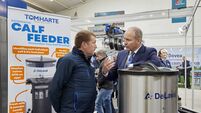No farming sector will be immune from taking action on water quality, Agriculture Minister Charlie McConalogue has warned as crunchtime efforts begin to save Ireland’s nitrates derogation ahead of the 2025 review.
Mr McConalogue told attendees at the launch of Teagasc’s ‘Better Farming for Water campaign: Eight Actions for Change’ that the project was one of the most important he would attend as minister.
The campaign builds on the progress made through programmes such as ACP, ACRES, ASSAP, Farming for Water EIP, Waters of LIFE, Blue Dot Catchments, Slaney project and others that improve water quality.
Proactive
Improvement in Irish water quality is urgently needed to secure the nitrates derogation post-2025.
“We are at a really important point in terms of water quality in the country,” Mr McConalogue said, and that the launch was the start of “proactive change”.
“Water is, and ever more so, will be a deciding factor in the continued success and ambition we all have here for our agri-food sector.
“No one part of the industry is immune to the impact that water quality will have, so no one part can be immune in terms of taking the action we need to take,” he said, adding that farmers would be able to make better decisions and be more aware of how water is impacted by farm activities because of the campaign.
“We know Irish water quality is relatively good compared to other EU member states; however, it is not where it should be, where we want it to be, or where it can be.
“For the next [nitrates] derogation, the commission wants to see water quality remaining stable where it is already good, and where water quality is less than good, it wants to see improvements,” the minister added.
Eight actions
The campaign sets out a series of eight actions that will reduce nutrient, sediment, pesticide and pathogen loss to water bodies and increase the proportion of river water bodies with agriculture as significant pressure to high/good ecological status.
Actions listed can be categorised under three key areas — nutrient management, land management, and farmyard management.
The campaign, which will strive to make every Irish farmer aware of their farm’s nutrient surplus as well as ways to mitigate losses from their farms, is part of a Government-wide response to Ireland’s water quality woes.
The programme will be built around eight key actions, including soil fertility, slurry spreading and storage practices, protecting watercourses through fences and buffer zones, and cover crops.
Teagasc director Frank O’Mara said water quality is a “right” for all citizens and communities, so it is important steps are taken to make improvements.
“It’s also essential for business and for leisure, but from an agri-food point of view, water quality is an intrinsic part of our sustainability credentials, so whether you are a dairy farmer whose product ends up exported all around the world, or a beef farmer or sheep or tillage farmer, water quality is something you want to be positively associated with your product… it is an issue for all farmers in all parts of the country,” said Prof O’Mara.
“Our water quality is not where we want it to be. Around 46% of our surface water bodies are not in either good or excellent status.”
Prof O’Mara said that most of those not good or excellent were categorised as “moderate” and that, in many cases, small improvements could make a big difference to the overall picture.
“This means that one jump of category would bring most of those into good or excellent status, so I think we should take some encouragement from that — that this is not a challenge which is unmeetable.
“We need a step up in both resources and ambition.”
Eight actions
The programme will include a combination of research, advice, and education and incentives as well as the eight recommended actions.
These are:
- Reduce purchased nitrogen (N) and phosphorus (P) surplus per hectare;
- Ensure soil fertility is optimal for lime, phosphorus, and potassium;
- Ensure application of fertiliser and organic manure at appropriate times and conditions;
- Have sufficient slurry and soiled water storage capacity;
- Manage and minimise nutrient loss from farmyards and roadways;
- Fence off watercourses to prevent bovine access;
- Promote targeted use of mitigation actions such as riparian margins, buffer strips, and sediment traps to mitigate nutrient and sediment loss to water;
- Maintain over-winter green cover to reduce nutrient leaching from tillage soils.
‘Determination for change’
“What we are about trying to do is to amplify the impact of [existing water quality initiatives], and to do that we certainly do need a major step up in terms of both resources and ambition,” said Prof O’Mara.
“When we set out in any campaign to support farmers to change their practices and adopt new technologies, we do recognise that farmers need support at three levels.
“There is a very important role for policy and incentives, and we do see industry already taking a lot of action in terms of sustainability bonus schemes, to support farmers in making these changes. But the third pillar is research, advice, and education.
“We know that will be critical in ensuring our success in improving water quality.”
Prof O’Mara said that water quality advice will be incorporated into the work of all Teagasc advisors. Water quality will also be featured at all Teagasc events, and he said that the organisation would also provide a suite of tools for farmers and advisors to support future actions.
Teagasc will hold at least four water quality events in each of its regions each year, and will appoint water quality lead advisors for each of the catchments.
“Unlike the challenge of climate change, water quality is very local and what works or is applicable in one region is not necessarily the same as in another,” he said.
It’s all about promoting the right nutrients, at the right rate, at the right place, at the right time.
“It’s established now that we have one of the best databases on water quality in the world. We have 16 years of intensive measurements and monitoring, and it has just been renewed for another four years with €13m funding.”
No significant improvement
Teagasc senior research officer Daire Ó hUallacháin said that there had been no significant improvement in our water quality in recent years.
“Unfortunately, at a national scale, we are exceeding the threshold of 8mg of nitrates per litre. It’s most challenging in some of the freer draining soils in the south and south-east, for example,” said Mr Ó hUallacháin.
“When it comes to phosphorous, the guidelines are 0.035mg/L. At a national scale, we are below this threshold, but, again, regional scale there can be localised challenges. This time, it is in more poorly draining soils, such as parts of the north-east.”
He said this poor water quality can manifest itself in excessive plant or algae growth.
“This is damaging to the aquatic ecosystem in its own right, but it makes it more difficult that as these plants die back, they contribute to eutrophic conditions, further degrading our aquatic ecosystems, and making them unsuitable for a range of species.”
Poor practices
He also highlighted that the impacts of poor practices may not be evident until further downstream.
“In one instance, in a catchment down in the south, we are seeing high water quality status at the upper areas of the catchment, and for most of the catchment, we are seeing good status, but, unfortunately, when it comes to the estuary, we are seeing that water quality at this stage is now down to moderate.”
He said some of the biggest gains could be made by focusing on reducing sources of nutrients, e-coli, or sediment making their way into the water body.
Prof O’Mara said he is “confident” the steps would make a significant difference.
“There has been a real change and determination on the part of the industry that this is something that we are really going to address. We are starting from the point that we have built up huge knowledge and experience of what works from working with our partners and how we go about approaching the issue in a locality.”












